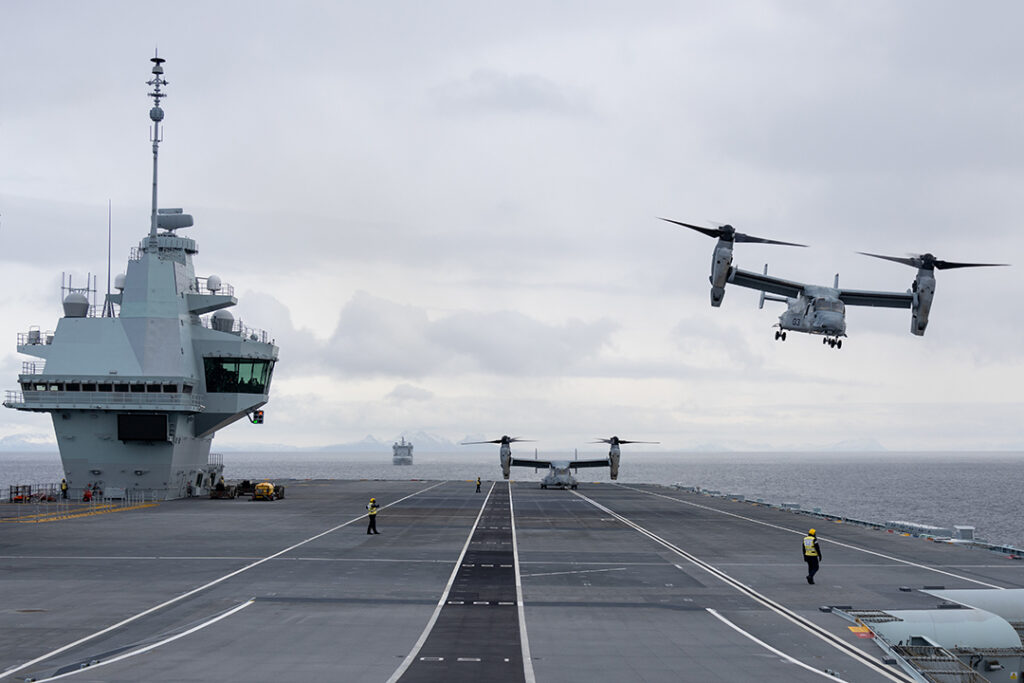THE WATCH STAFF
Britain is making defense of the Arctic a priority of its future military strategy, which also urges its fellow NATO nations to have a more energetic presence in the High North.
Ben Wallace, the U.K. defense secretary, announced the March 29, 2022, publication of his country’s revised strategy, “Defence Contribution in the High North,” during a visit to Norway for the large-scale Cold Response military exercise.
“The U.K. Armed Forces will be doing more with our close Arctic allies and partners, as part of NATO, bilaterally, and through other multilateral groupings such as the Joint Expeditionary Force,” Wallace said in a forward to the strategy document released by the Ministry of Defence.
“The Royal Navy … will periodically operate in the High North alongside Allies and partners, the Army will expand its cold-weather training, and the RAF [Royal Air Force] will deploy P-8A maritime patrol aircraft to the region and continue participating in Icelandic air policing,” Wallace said.
The document notes that melting Arctic ice opens up both threats and opportunities in the region.
“Russia is taking an increasingly militarized approach to the region; and China is supporting its proposed Polar Silk Road with a range of infrastructure and capabilities that have dual-use potential,” Wallace said.
Release of the strategy came as the Norwegian-led Cold Response wound down. The exercise involved 30,000 personnel from 27 NATO and partner nations. Britain, which doesn’t have Arctic territory, was a major contributors to Cold Response — most notably the participation of the HMS Prince of Wales, one of the Royal Navy’s two new aircraft carriers, according to the website Defense News.
(Pictured: U.S. Marines take off in two MV-22B Ospreys from the HMS Prince of Wales in the Norwegian Sea during Cold Response on March 26, 2022.)
“The U.K. has strong relationships with almost all Arctic states and has a responsibility to support our Allies and partners to preserve the stability and security of the region; we have been operating there for many years,” the strategy states.
The document also lays out how Britain will develop its Arctic capabilities by:
- Building on Royal Marine Commando Force cooperation with Norway and the United States, with the potential to expand cooperation to include the Netherlands.
- Focusing on interoperability with Canada, Denmark, France, Norway, the Netherlands and the U.S. in the development of the next generation of anti-submarine warfare frigates. Russia is increasing its submarine activity in the Arctic to Cold War levels, according to the Ministry of Defence.
- The British Army will advance its cold-weather training alongside Nordic partners.
The strategy also restates the British commitment to the stability of the region, which includes upholding the rules-based international system such as the United Nations Convention on the Law of the Sea. It also notes that the U.K. plays an important role in protecting critical underwater national infrastructure and ensuring freedom to operate in the North Atlantic, especially in the Greenland-Iceland-U.K. Gap.
The renewed British focus on the Arctic was welcomed by NATO partner Norway.
Norwegian Defence Minister Odd Roger Enoksen said that his country, as both a member of NATO and a neighbor of Russia, wants more allied activity the region, according to Agency France-Presse. “The U.K. is our most important ally in Europe,” he said.
Wallace, his U.K. counterpart, emphasized at the Cold Response announcement that Norway can count on Britain.
“I think we’ll be in the area a lot more,” he said, according to Reuters. “Our ambition is bold, and we will make sure that we are there to answer the demand if called upon.”
IMAGE CREDIT: LANCE CPL. ELIAS E. PIMENTEL III/U.S. MARINE CORPS)

